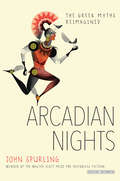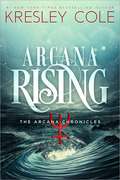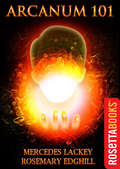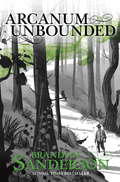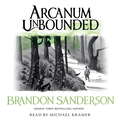- Table View
- List View
Arcadian Nights: The Greek Myths Reimagined
by John SpurlingThe vibrant retelling of the central Greek myths by acclaimed novelist John Spurling, author of The Ten Thousand Things, winner of the 2015 Walter Scott Prize for Historical Fiction The classical Greek intellectual tradition pervades nearly every aspect of our modern Western civilization. Our logic and science, our philosophy, politics, literature, architecture, and art are all indebted to the ancient inhabitants of the small mountainous Mediterranean country. And the powerful myths of the Greeks, refined by Homer, Hesiod, Herodotus, and the great Greek dramatists, still resonate at the core of our culture. Taking as his starting point many of the famous tourist sites in the Peloponnese, where the stories are set, John Spurling, winner of the 2015 Walter Scott Prize for Historical Fiction, freshly imagines key narratives from the Greek canon, including tales of the doomed house of Atreus (notably Agamemnon, leader of the Greeks at Troy, murdered by his wife in his palace bathroom); of the god Apollo; goddess Athene; Theseus, scourge of the Minotaur; the Twelve Labors of Heracles; and Perseus, rescuer of Andromeda. In this vibrant, gripping and often grisly retelling of the Greek myths, stories of murder, power, revenge, love, and traumatic family relationships are made new again for our time with wit and relish by a gifted author. Spurling has added scene, dialogue, and context, while always staying true to the spirit of the original myth.
Arcadio
by William GoyenCompleted while he was dying, William Goyen's Arcadio is one of the most affecting and imaginative farewells to life ever written. Arcadio, whose voice is inimitably Goyenesque, is a creature from beyond the normal walks of life. Half man, half woman, raised in a whorehouse and for years the veteran exhibitionist in an itinerant circus sideshow, he has escaped from the show and has been wandering in a quest for his lost family. Speaking intimately to the reader, he tells the bizarre and fantastic tale of his life. This unforgettable novel is the crown of Goyen's exploration of the forms and feelings that could be compassed within fiction.
Arcady in Australia: The evocation of Australia in nineteenth-century English Literature
by Coral LansburyThis provocative book examines the vision of Australia in nineteenth-century English literature. The industrial revolution destroyed the myth of an idyllic rural way of life in England, and writers like Charles Dickens, Bulwer Lytton and Charles Reade created it anew in the improbable environment of Australia. The popular image of Australia in English literature was Arcadian; in turn it dominated the thought and traditions of writing in Australia. The man who supplied the material for English writers was Samuel Sidney; he was for a time regarded as an expert on Australia, although he had never set foot in the antipodes and all his material was second-hand. His influence on the literature of the period, and consequently on Australia, has received scant attention. Sidney's influence is fully examined; the book also offers entirely new material on Wakefield, Dickens, Lytton and Reade. It provides a new and challenging interpretation of literature and social history in both England and Australia.
Arcady's Goal
by Eugene YelchinWhen twelve-year-old Arcady is sent to a children's home after his parents are declared enemies of the state in Soviet Russia, soccer becomes a way to secure extra rations, respect, and protection but it may also be his way out if he can believe in and love another person--and himself.
Arcana
by Jessica LeakeA romantic, suspenseful, genre-bending debut set in Edwardian London.Amid the sumptuous backdrop of the London season in 1905, headstrong Katherine Sinclair must join the ranks of debutantes vying for suitors. Unfortunately for Katherine, she cannot imagine anything more loathsome--or dangerous. To help ease her entrance into society, Katherine's family has elicited the assistance of the Earl of Thornewood, a friend and London's most eligible bachelor, to be her constant companion at the endless fetes and balls. But upon her arrival in London, Katherine realizes there will be more to this season than just white gowns and husband hunting.Through her late mother's enchanted diary, Katherine receives warning to keep hidden her otherworldly ability to perform arcana, a magic fueled by the power of the sun. Any misstep could mean ruin--and not just for her family name. The Order of the Eternal Sun is everywhere--hunting for those like her, able to feed on arcana with only a touch of the hand.But society intrigue can be just as perilous as the Order. The machinations of the fashionable elite are a constant threat, and those who covet Katherine's arcana, seeking the power of her birthright, could be hiding behind the façade of every suitor--even the darkly handsome Earl of Thornewood.With so much danger and suspicion, can she give her heart to the one who captivates her, or is he just another after her power?
Arcana
by Paul Kane"Arcana is a hugely entertaining read, a real rollercoaster ride of ups and downs that keep the pages turning until the very end, and another work of high quality from this prolific author.&”—Starburst Magazine In an alternate world where real magic exists, its practitioners are hunted down by police officers called M-forcers. But some groups are fighting back! Callum McGuire is a new M-forcer who once worked the quiet streets of London. As an orphan, Callum has been brought up to believe that all magic is evil, but the more he sees of The M-forcers&’ cruel methods (implemented by General Nero Stark, and his second-in-command Sherman Pryce), the more he begins to question whether or not they are right. And when he unwittingly encounters a member of the rebel group called Arcana, he&’s introduced to their world and realises that nothing will ever be the same again. Join award-winning and bestselling author Paul Kane (the sell-out phenomenon Sherlock Holmes and the Servants of Hell, the Hooded Man series, and the bestselling Before) as he shows you a kind of magic you&’ve never seen…
Arcana Academy (Arcana Academy)
by Elise Kova&“Magical from nail-biting beginning to shocking end!&”—Danielle L. Jensen, #1 New York Times bestselling author of A Fate Inked in BloodA woman who wields magical tarot cards lands herself in a false engagement with the headmaster of a mysterious academy in this first installment of an enthralling fantasy romance series from the bestselling author of A Deal with the Elf King.Clara Graysword has survived the underworld of Eclipse City through thievery, luck, and a whole lot of illegal magic. After a job gone awry, Clara is sentenced to a lifetime in prison for inking tarot cards—a rare power reserved for practitioners at the elite Arcana Academy.Just when it seems her luck has run dry, the academy&’s enigmatic headmaster, Prince Kaelis, offers her an escape—for a price. Kaelis believes that Clara is the perfect tool to help him steal a tarot card from the king and use it to re-create an all-powerful card long lost to time.In order to conceal her identity and keep her close, Kaelis brings Clara to Arcana Academy, introducing her as the newest first-year student and his bride-to-be.Thrust into a world of arcane magic and royal intrigue, where one misstep will send her back to prison or worse, Clara finds that the prince she swore to hate may not be what he seems. But can she risk giving him power over the world—and her heart? Or will she take it for herself?Book One of The Arcana Academy Series
Arcana Academy: an enthralling, addictive, unputdownable fantasy romance (Arcana Academy)
by Elise KovaClara Graysword has survived the underworld of Eclipse City through thievery, luck, and a whole lot of illegal magic. After a job goes awry, Clara is sentenced to a lifetime in prison for inking tarot cards - a rare power reserved for practitioners at the elite Arcana Academy. Just when it seems her luck has run dry, the academy's enigmatic headmaster, Prince Kaelis, offers her an escape - for a price. Kaelis believes that Clara is the perfect tool to help him steal a tarot card from the king and use it to re-create an all-powerful card long lost to time. In order to conceal her identity and keep her close, Kaelis brings Clara to Arcana Academy, introducing her as the newest first-year student and his bride-to-be. Thrust into a world of arcane magic and royal intrigue, where one misstep will send her back to prison or worse, Clara finds that the prince she swore to hate may not be what he seems. But can she risk giving him power over the world - and her heart? Or will she take it for herself?
Arcana Academy: an enthralling, addictive, unputdownable fantasy romance (Arcana Academy)
by Elise KovaA woman who wields magical tarot cards lands herself in a false engagement with the headmaster of a mysterious academy in this first installment of an enthralling fantasy romance series from the bestselling author of A Deal with the Elf King.Clara Graysword has survived the underworld of Eclipse City through thievery, luck, and a whole lot of illegal magic. After a job gone awry, Clara is sentenced to a lifetime in prison for inking tarot cards-a rare power reserved for practitioners at the elite Arcana Academy.Just when it seems her luck has run dry, the academy's enigmatic headmaster, Prince Kaelis, offers her an escape-for a price. Kaelis believes that Clara is the perfect tool to help him steal a tarot card from the king and use it to re-create an all-powerful card long lost to time.In order to conceal her identity and keep her close, Kaelis brings Clara to Arcana Academy, introducing her as the newest first-year student and his bride-to-be.Thrust into a world of arcane magic and royal intrigue, where one misstep will send her back to prison or worse, Clara finds that the prince she swore to hate may not be what he seems. But can she risk giving him power over the world-and her heart? Or will she take it for herself?
Arcana Mundi: Magic and the Occult in the Greek and Roman Worlds
by Georg LuckDiscover a different way to see classical civilization in this collection of ancient Greek and Roman texts on magic and the occult.Magic, miracles, daemonology, divination, astrology, and alchemy were the arcana mundi, the “secrets of the universe,” of the ancient Greeks and Romans. In this path-breaking collection of Greek and Roman writings on magic and the occult, Georg Luck provides a comprehensive sourcebook and introduction to magic as it was practiced by witches and sorcerers, magi and astrologers, in the Greek and Roman worlds.In this new edition, Luck has gathered and translated 130 ancient texts dating from the eighth century BCE through the fourth century CE. Thoroughly revised, this volume offers several new elements: a comprehensive general introduction, an epilogue discussing the persistence of ancient magic into the early Christian and Byzantine eras, and an appendix on the use of mind-altering substances in occult practices. Also added is an extensive glossary of Greek and Latin magical terms.In Arcana Mundi Georg Luck presents a fascinating?and at times startling?alternative vision of the ancient world. “For a long time it was fashionable to ignore the darker and, to us, perhaps, uncomfortable aspects of everyday life in Greece and Rome,” Luck has written. “But we can no longer idealize the Greeks with their “artistic genius” and the Romans with their “sober realism.” Magic and witchcraft, the fear of daemons and ghosts, the wish to manipulate invisible powers?all of this was very much a part of their lives.”“An excellent translation of ancient texts on the subject, but it’s a lot more than that. It’s a glimpse into the minds of the everyday people of the times and what made them turn, what made them stop, what made them look over their shoulders.” —Courier-Gazette,(Rockland, Maine)“No one currently at work in ancient magic or related fields can remotely compare with Luck for the breadth and profundity of his knowledge of the literary texts . . . or for the humility and lightness of touch with which he conveys his scholarship.” —Daniel Ogden, author of Magic, Witchcraft, and Ghosts in the Greek and Roman Worlds
Arcana Rising (The Arcana Chronicles #5)
by Kresley ColeLosses mount and deadly new threats converge in this next action-packed tale of the Arcana Chronicles by #1 New York Times bestseller Kresley Cole. When the battle is done . . . The Emperor unleashed hell and annihilated an army, jeopardizing the future of mankind--but Circe struck back. The epic clash between them devastates the Arcana world and nearly kills Evie, separating her from her allies. And all hope is lost . . . With Aric missing and no sign that Jack and Selena escaped Richter's reach, Evie turns more and more to the darkness lurking inside her. Two Arcana emerge as game changers: one who could be her salvation, the other her worst nightmare. Vengeance becomes everything. To take on Richter, Evie must reunite with Death and mend their broken bond. But as she learns more about her role in the future--and her chilling past--will she become a monster like the Emperor? Or can Evie and her allies rise up from Richter's ashes, stronger than ever before?
Arcana: A Novel Of The Sylvani (Novels Of The Sylvani Ser. #1)
by Jessica LeakeA romantic, suspenseful, genre-bending debut set in Edwardian London.Amid the sumptuous backdrop of the London season in 1905, headstrong Katherine Sinclair must join the ranks of debutantes vying for suitors. Unfortunately for Katherine, she cannot imagine anything more loathsome-or dangerous. To help ease her entrance into society, Katherine's family has elicited the assistance of the Earl of Thornewood, a friend and London's most eligible bachelor, to be her constant companion at the endless fetes and balls. But upon her arrival in London, Katherine realizes there will be more to this season than just white gowns and husband hunting.Through her late mother's enchanted diary, Katherine receives warning to keep hidden her otherworldly ability to perform arcana, a magic fueled by the power of the sun. Any misstep could mean ruin-and not just for her family name. The Order of the Eternal Sun is everywhere-hunting for those like her, able to feed on arcana with only a touch of the hand.But society intrigue can be just as perilous as the Order. The machinations of the fashionable elite are a constant threat, and those who covet Katherine's arcana, seeking the power of her birthright, could be hiding behind the façade of every suitor-even the darkly handsome Earl of Thornewood.With so much danger and suspicion, can she give her heart to the one who captivates her, or is he just another after her power?
Arcana: A Novel of the Sylvani (Novels of the Sylvani #1)
by Jessica Leake"Leake weaves together a beautifully rendered historical setting, magic and romance in this stunning debut. " --Elizabeth May, author of The Falconer Amid the sumptuous backdrop of the London season in 1905, headstrong Katherine Sinclair must join the ranks of debutantes vying for suitors. Unfortunately for Katherine, she cannot imagine anything more loathsome--or dangerous. To help ease her entrance into society, Katherine’s family has elicited the assistance of the Earl of Thornewood, a friend and London’s most eligible bachelor, to be her constant companion at the endless fetes and balls. But upon her arrival in London, Katherine realizes there will be more to this season than just white gowns and husband hunting. Through her late mother’s enchanted diary, Katherine receives warning to keep hidden her otherworldly ability to perform arcana, a magic fueled by the power of the sun. Any misstep could mean ruin--and not just for her family name. The Order of the Eternal Sun is everywhere--hunting for those like her, able to feed on arcana with only a touch of the hand. But society intrigue can be just as perilous as the Order. The machinations of the fashionable elite are a constant threat, and those who covet Katherine’s arcana, seeking the power of her birthright, could be hiding behind the facade of every suitor--even the darkly handsome Earl of Thornewood. With so much danger and suspicion, can she give her heart to the one who captivates her, or is he just another after her power?
Arcana: The Lost Heirs (Arcana)
by Sam Prentice-JonesAn Indies Introduce SelectionDebut author/illustrator Sam Prentice-Jones explores fighting against your destiny and reconciling the actions of your ancestors in Arcana: The Lost Heirs, a tarot-inspired fantasy graphic novel for young adults.James, Daphne, Koko, and Sonny have all grown up surrounded by magic in the Arcana, an organization of witches that protects the magical world, run by the mysterious and secretive Majors. Eli Jones, however, hadn’t even known other witches existed . . . until he stumbled into James. As James introduces him to the world of the Arcana, Eli finds the family he never had and a blossoming romance with James.The five new friends soon realize that sinister things are afoot, and everything may not be what it seems at the Arcana. When the group delves deeper into the mystery surrounding the deaths of their parents and the Majors’ rise to power, they discover that they’re at the center of a curse—one they’ve just unwittingly set into motion. As the friends search for answers, they’ll have to confront the cursed legacy that links them in hopes of freeing their futures.
Arcane Circle
by Linda RobertsonAn action-packed urban fantasy where deadly secrets, supernatural politics, and passionate romance collide.After surviving a brutal battle with the forces of Fairy, Persephone Alcmedi is left with more problems than answers. She now carries dangerous secrets she must hide from both the magical and mundane worlds—and she&’s somehow responsible for feeding and sheltering dozens of displaced supernatural creatures living behind her cornfield. As if that weren&’t enough, her foster daughter Beverly&’s tenth birthday party is right around the corner. But the most pressing complication comes from Seph&’s boyfriend, Johnny, who has revealed himself as the wærewolf Domn Lup—the king of the werewolf world. The current ruler of the wære realm is on his way from Romania to verify Johnny&’s claim, but Johnny hides a perilous truth: his magic is locked within the intricate tattoos on his skin. Without it, his crown—and his life—are at risk. Seph and Johnny must race to unlock his magic before political rivals destroy him. Yet in the cutthroat arcane world, strength must be constantly proven, alliances shift like shadows, and every victory comes at a price. Now Seph must decide how far she&’s willing to go to protect the man she loves—and whether the cost will be paid in power, loyalty, or blood.
Arcanum
by Simon MordenRome was the center of the most powerful empire the world had ever seen, but that didn't stop it falling to Alaric the Goth, his horde of barbarian tribesmen and their wild spell-casting shamans. Having split the walls with their sorcery and slaughtered the inhabitants with their axes, the victors carved up the empire into a series of bickering states which were never more than an insult away from war.A thousand years later, and Europe has become an almost civilized place. The rulers of the old Roman palatinates confine their warfare to the short summer months, trade flourishes along the rivers and roads, and farming has become less back-breaking, all due to the magic, bestowed by gods, that infuses daily life.Even the barbarians' gods have been tamed: where once human sacrifices poured their blood onto the ground, there are parties and picnics, drinking and singing, fit for decent people and their children.But it looks like the gods are going to have the last laugh before they slip quietly into ill-remembered obscurity...
Arcanum
by Simon MordenThe kingdom of Carinthia is rich, powerful and undefeated. A thousand years ago, its ancestors were the spell-wielding northern tribes who crushed the Roman Empire. Their legendary hexmasters can destroy whole armies and turn battlefields into fiery lakes of lava.Magic is Carinthia's wealth, protection and way of life. But the age of magic is dying. Some would do anything to see it return: any act, no matter how terrible, is justified, so long as the hexmasters can still protect their homeland.The kingdom is poised between order and chaos - and the smallest spark is the difference between disaster and triumph.ARCANUM is powerful new epic fantasy from an award-winning author.
Arcanum 101
by Rosemary Edghill Mercedes LackeyA teenager with a magical gift is sent to an unusual boarding school in this urban fantasy novel by the acclaimed co-authors of the Shadow Grail series.Fifteen-year-old Tomas Torres has a most unusual gift: he can start fires with his fingertips and conjure fireballs with his hands. When he&’s arrested for a mysterious arson, the court decides to convict him—despite the lack of evidence—and send him off to school. As far as Tomas is concerned, St. Rhiannon&’s School for the Gifted and Exceptional Student sounds like jail by another name. But once he arrives on campus, he&’s surprised to discover he&’s not alone. St. Rhia's is a school for students of all ages with gifts like Tomas's: pre-cogs, storm-callers, witches, healers, wizards, techno-shamans, psionics, firestarters, teleporters, psychics, sensitives and much more. Things he could never have imagined are common occurrences at St. Rhia's, and soon Tomas is eager to learn everything he can from his attractive young mentor, VeeVee. While Tomas may be gifted, he must learn to control his powers and live by the laws of magic.And there&’s no time to lose, because Tomas and his friends are about to embark on journey through St. Rhia's and beyond, testing their gifts in the outside world and the magical worlds of Chaos.
Arcanum Unbounded: The Cosmere Collection
by Brandon SandersonAn all-new 120-page Stormlight Archive novella, "Edgedancer," will be the crown jewel of Arcanum Unbounded: The Cosmere Collection, the first book of short fiction by #1 New York Times bestselling author Brandon Sanderson. The collection will include nine works in all. The first eight are: "The Hope of Elantris" (Elantris) "The Eleventh Metal" (Mistborn) "The Emperor's Soul" (Elantris) "Allomancer Jak and the Pits of Eltania, Episodes 28 through 30" (Mistborn) "White Sand" (excerpt; Taldain) "Shadows for Silence in the Forests of Hell" (Threnody) "Sixth of Dusk" (First of the Sun) "Mistborn: Secret History" (Mistborn) These wonderful works, originally published on Tor. com and elsewhere individually, convey the expanse of the Cosmere and tell exciting tales of adventure Sanderson fans have come to expect, including the Hugo Award-winning novella, "The Emperor's Soul" and an excerpt from the graphic novel "White Sand. " Arcanum Unbounded will also contain the 120-page Stormlight Archive novella "Edgedancer," which will appear in this book for the first time anywhere. It is a story of Lift, taking place between Words of Radiance and the forthcoming Oathbringer. Finally, this collection includes essays and illustrations for the various planetary systems in which the stories are set. The Cosmere The Mistborn series Mistborn: The Final Empire The Well of Ascension The Hero of Ages Alloy of Law Shadows of Self Bands of Mourning The Stormlight Archive The Way of Kings Words of Radiance Edgedancer (Novella) Oathbringer (forthcoming) Collection Arcanum Unbounded Other Cosmere Titles Elantris Warbreaker Rithmatist The Alcatraz vs. the Evil Librarians series Alcatraz vs. the Evil Librarians The Scrivener's Bones The Knights of Crystallia The Shattered Lens The Dark Talent The Reckoners Steelheart Firefight Calamity
Arcanum Unbounded: The Cosmere Collection
by Brandon SandersonAn all-new 120-page Stormlight Archive novella, "Edgedancer," will be the crown jewel of Arcanum Unbounded: The Cosmere Collection, the first book of short fiction by #1 New York Times bestselling author Brandon Sanderson. The collection will include nine works in all. The first eight are: "The Hope of Elantris" (Elantris) "The Eleventh Metal" (Mistborn) "The Emperor's Soul" (Elantris) "Allomancer Jak and the Pits of Eltania, Episodes 28 through 30" (Mistborn) "White Sand" (excerpt; Taldain) "Shadows for Silence in the Forests of Hell" (Threnody) "Sixth of Dusk" (First of the Sun) "Mistborn: Secret History" (Mistborn) These wonderful works, originally published on Tor.com and elsewhere individually, convey the expanse of the Cosmere and tell exciting tales of adventure Sanderson fans have come to expect, including the Hugo Award-winning novella, "The Emperor's Soul" and an excerpt from the graphic novel "White Sand." Arcanum Unbounded will also contain the 120-page Stormlight Archive novella "Edgedancer," which will appear in this book for the first time anywhere. It is a story of Lift, taking place between Words of Radiance and the forthcoming Oathbringer. Finally, this collection includes essays and illustrations for the various planetary systems in which the stories are set. The Cosmere, The Mistborn series, Mistborn: The Final Empire, The Well of Ascension, The Hero of Ages, Alloy of Law, Shadows of Self, Bands of Mourning, The Stormlight Archive, The Way of Kings, Words of Radiance, Edgedancer (Novella), Oathbringer (forthcoming), Collection, Arcanum Unbounded Other Cosmere Titles: Elantris, Warbreaker, Rithmatist, The Alcatraz vs. the Evil Librarians series, Alcatraz vs. the Evil Librarians, The Scrivener's Bones, The Knights of Crystallia, The Shattered Lens, The Dark Talent, The Reckoners, Steelheart, Firefight, Calamity At the Publisher's request, this title is being sold without Digital Rights Management Software (DRM) applied.
Arcanum Unbounded: The Cosmere Collection
by Brandon SandersonWelcome to New York Times and Sunday Times bestseller Brandon Sanderson's first collection of short fiction.These wonderful works, originally published individually, have been collected for the first time and convey the true expanse of the Cosmere. Telling the exciting tales of adventure Sanderson fans have come to expect, Arcanum Unbounded include the Hugo Award-winning novella 'The Emperor's Soul', an excerpt from the graphic novel 'White Sand', and the never-before-published Stormlight Archive novella 'Edgedancer'.The collection will include nine works in all:'Edgedancer' (Stormlight Archive)'The Hope of Elantris' (Elantris)'The Eleventh Metal' (Mistborn)'The Emperor's Soul' (Elantris)'Allomancer Jak and the Pits of Eltania' (excerpt; Mistborn)'White Sand' (excerpt; Taldain)'Shadows for Silence in the Forests of Hell' (Threnody) 'Sixth of Dusk' (First of the Sun)'Mistborn: Secret History' (Mistborn)This superb collection also includes essays and illustrations which offer an insight into the numerous worlds in which the stories are set.
Arcanum Unbounded: The Cosmere Collection
by Brandon SandersonWelcome to New York Times and Sunday Times bestseller Brandon Sanderson's first collection of short fiction.These wonderful works, originally published individually, have been collected for the first time and convey the true expanse of the Cosmere. Telling the exciting tales of adventure Sanderson fans have come to expect, Arcanum Unbounded include the Hugo Award-winning novella 'The Emperor's Soul', an excerpt from the graphic novel 'White Sand', and the never-before-published Stormlight Archive novella 'Edgedancer'.The collection will include nine works in all:'Edgedancer' (Stormlight Archive)'The Hope of Elantris' (Elantris)'The Eleventh Metal' (Mistborn)'The Emperor's Soul' (Elantris)'Allomancer Jak and the Pits of Eltania' (excerpt; Mistborn)'White Sand' (excerpt; Taldain)'Shadows for Silence in the Forests of Hell' (Threnody) 'Sixth of Dusk' (First of the Sun)'Mistborn: Secret History' (Mistborn)This superb collection also includes essays and illustrations which offer an insight into the numerous worlds in which the stories are set.
Arcata (Images of America)
by Humboldt County Historical Society Jessie FaulknerArcata, a bright jewel surrounded by the redwood forested hills of northern Humboldt Bay, was once the territory of the Wiyot Indians. The tribe only barely survived massacres and relocation after a town was founded there in 1850, a supply point for gold seekers at nearby mines. That town soon evolved into a center for a thriving lumber industry that fed sawmills and a barrel factory, and dairies that prospered on the pastoral Arcata Bottom. Home to Humboldt State University and the much loved Humboldt Crabs baseball team, Arcata is attracting new businesses, industries, and national attention for its innovative Arcata Marsh public works project.
Arcelik: From a Dealer Network to an Omnichannel Experience
by Ayelet Israeli Fares KhraisArcelik Turkey, the country's market leader in household appliances, was at an omnichannel crossroads in January 2020. Arcelik was a B2B player utilizing a dealership network with an umbrella of brands and had one of the largest brick-and-mortar store networks in Turkey. In 2015, Arcelik, which was focused on offline sales, realized that online demand was growing and they were behind the competition, which was intensified due to the entry of global household appliances brands and online marketplaces to Turkey. So, they decided on a company-wide omnichannel transformation scheduled to go-live by 2020. They faced resistance from both dealers and employees. While Arcelik tried to gain the dealers' trust and buy-in, they experimented with one of their smaller brands on online marketplaces to learn more about e-commerce. In early 2020, Arcelik felt the squeeze as pressure mounted from the growing presence of marketplaces and online demand. They needed to find a way to cater to the online demand quickly while keeping their established partners happy.
